7 Best Astronomy Binoculars for Stargazing in 2025 – Reviews & Top Picks
Last Updated on

Binoculars are a great tool to help get you into stargazing and often much less expensive than telescopes—and definitely more versatile. Choosing the right brand of astronomy binoculars can be quite a challenge, however. There are so many different brands of binoculars available, and unlike telescopes, these devices are usually for jobs other than stargazing.
We review binoculars every very few days, and we have chosen seven different brands to review for you. Each brand is for astronomy and low-light viewing, and you can see what type of features interest you. We’ve also included a buyer’s guide for astronomy binoculars. In this guide, we discuss everything a pair of high-quality astronomy binoculars should be. Keep reading for our detailed reviews, as we compare objective lenses, magnification, weight, and durability, to help you make an educated purchase.
Let’s look at the seven different brands of astronomy binoculars we have chosen to review for you.

A Quick Comparison of our Favorite Picks in 2025:
| Image | Product | Details | ||
|---|---|---|---|---|
| Best Overall |
 |
Gosky Titan Astronomy Binoculars |
|
CHECK PRICE |
| Best Value |
 |
Celestron 71198 Cometron Binoculars |
|
CHECK PRICE |
| Premium Choice |
 |
Zhumell Tachyon Astronomy Binoculars |
|
CHECK PRICE |
 |
Orion 10151 Waterproof Astronomy Binoculars |
|
CHECK PRICE | |
 |
Celestron 71009 SkyMaster Giant Binoculars |
|
CHECK PRICE |
The 7 Best Astronomy Binoculars for Stargazing:
1. Gosky Titan Astronomy Binoculars – Best Overall
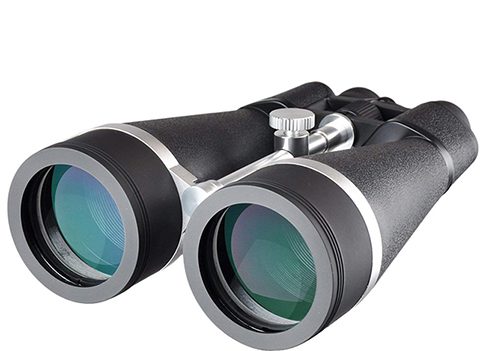
The Gosky 4332111342 Titan Astronomy Binoculars are our pick for the best overall. These binoculars feature large 80-mm objective lenses that let in plenty of light for a bright, clear image with plenty of contrast. The 20X zoom is strong enough to see craters on the moon as well as the moons of Jupiter. The Gosky Titans also come with a Digiscoping phone adapter that allows you to take pictures and movies with your cell phone.
At times we found it hard to focus, but when used with a tripod, it provided clear images with a wide field of view.
- 80-mm objective lens
- Digi scoping phone adapter
- 20X zoom
- Hard to focus
2. Celestron 71198 Cometron Binoculars – Best Value
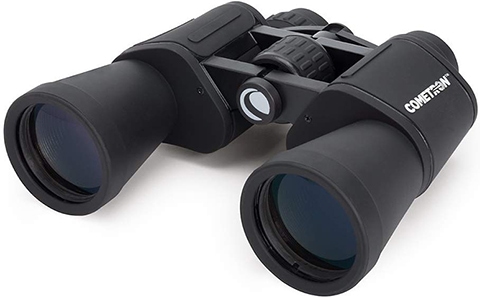
The Celestron 71198 Cometron Binoculars are our choice the best value, and we believe you will agree that these are the best astronomy binoculars for stargazing for the money. These binoculars feature an extra-wide field of view, and the 50-mm objective lenses capture plenty of light to provide a clear image. It also features a durable aluminum housing.
The downside to these binoculars is their low magnification. The 7X zoom provided by the binoculars is not enough to see many of the smaller objects in the night sky. We found them perfect for looking at the moon but could not see Jupiter’s moons.
- Wide field of view
- 50-mm objective lens
- Durable houses
- Low cost
- 7X zoom
3. Zhumell Tachyon Astronomy Binoculars – Premium Choice
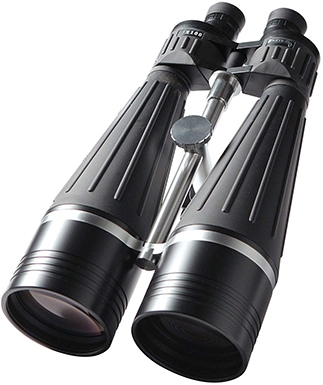
The Zhumell ZHUG002-1 Tachyon Astronomy Binoculars are our premium choice binoculars. These are perfect for those that want the best astronomy binoculars and aren’t afraid to spend a few extra dollars to get them. These powerful binoculars feature 25X magnification, allowing you to look further into space and pick up smaller objects than you can with most of the others on this list. The 100-mm objective lenses are the largest on this list and will bring in plenty of light to help present a clear image with plenty of contrast. It also features a 15-mm eye relief to make it easier to get your eye in a position to see the picture. The rubber around the eyepieces also folds back to use the binoculars while wearing glasses.
Unfortunately, these binoculars are quite pricey and are also the heaviest on this list at over 10 pounds. You will need to mount these on a tripod using the included tripod connecter to use them properly. There is also no cell phone connection available, which we would have liked on binoculars this powerful and this expensive.
- 100-mm objective lenses
- Eyeglass friendly
- 25X zoom
- 15-mm eye relief
- Tripod connection
- Expensive
- No Digiscope adapter
- Heavy
4. Orion 10151 Waterproof Astronomy Binoculars
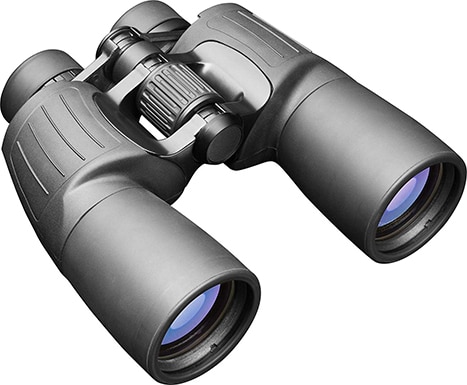
The Orion 10151 E-Series Waterproof Astronomy Binoculars are a larger pair of waterproof stargazing binoculars that feature a large 50-mm objective lens and a wide field of view. The 19-mm eye relief is easy on the eyes and is enough to use glasses with these binoculars.
The downside we experienced with these binoculars is that they are relatively heavy and quite large and can become cumbersome after a while. The image they provide is dim compared to many of the others on this list despite the large objective lenses, and the focus wheel is slow to turn and feels sludgy.
- 50-mm objective lens
- Wide field of view
- 19-mm eye relief
- Waterproof
- Heavy
- Slow focus wheel
5. Celestron 71009 SkyMaster Giant Binoculars
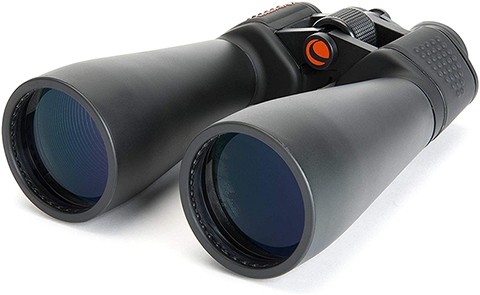
The Celestron 71009 SkyMaster Giant Binoculars is another large pair of astronomy binoculars on this list, and these feature oversized 70-mm multicoated objective lenses. The multicoated objective lenses reduce glare and false images, while the large lenses collect more light and produce a brighter and clearer image.
The Skymaster astronomy binoculars also include a tripod mount. We recommend using the tripod mount with the binoculars because, at almost four pounds, they are cumbersome, and fatigue will set in quickly while using them in a handheld fashion. The included neck strap is very flimsy, thin, and uncomfortable. We also feel that while these binoculars do present a bright clear image, the low 15X zoom is not going to bring out many objects in the night sky.
- 70-mm objective lens
- Multicoated optics
- Tripod adapter
- Heavy
- Thin neck strap
- Low magnification
- Related Read: What is The Bluewater Astronomical Society?
6. Levenhuk Bruno Plus Astronomy Binocular
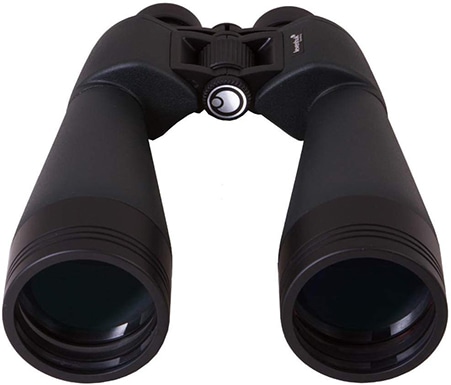
The Levenhuk 71147 Bruno Plus Astronomy Binoculars are large binoculars that feature an 80-mm lens. The large lenses provide a wide field of view and a bright image. We found that these binoculars produce a clear picture at night, and we were able to find the rings of Saturn and other distant objects.
The downside to this model is that it’s heavy and hard to carry long distances or hold over your head. We were also concerned about the durability of this model because one of our eyepieces was loose, and the hard-plastic shell can break easily if dropped.
- 80-mm objective lens
- Tripod attachment
- Heavy
- Not very durable
7. ESSLNB Giant Binoculars

The ESSLNB 3216583107 Giant Binoculars Astronomy is the last model of astronomy binoculars on our list. These binoculars feature a 20X zoom capability, which is enough to get a good view of the moon and even bring out the moons of Jupiter. The 80-mm lens allows plenty of light in and helps deliver a clear, sharp image. It has a durable aluminum frame and is entirely waterproof.
The downside to these binoculars is they are heavy. At over five pounds, these are among the heaviest stargazing binoculars on this list. We also had a difficult time using these binoculars with glasses.
- 20X zoom
- 80-mm objective lenses
- Waterproof
- Heavy
- Can’t use with glasses

Buyer’s Guide – Picking the Best Astronomy Binoculars
Let’s look at what features a set of astronomy binoculars should include.
Major Components
These next few things are the vital components of astronomy binoculars, and we recommend paying extra attention to these things.
Magnification
The amount of magnification a pair of binoculars provides is one of its most important features when using them for stargazing. To see the moons of Jupiter or the rings of Saturn, you will need at least 15X magnification, and even that can make seeing these objects a challenge. Anything below that might only be useful for looking at the moon or constellations.
Objective Lenses
The objective lens is another critical part of the astronomy binocular. The objective lens is the lens furthest from the eye. This lens collects light. The larger this lens is, the brighter your image will be. It will also increase your field of view.
Because we will use these binoculars in the dark, it’s vital to get the largest objective lens you can find. We recommend an objective lens no smaller than 50-mm for stargazing.
Weight
Weight is the last major component of astronomy binoculars. Some binoculars made for stargazing have huge objective lenses that can cause your binoculars to weigh up to ten pounds. When you are looking up at the stars, this weight will rest right on your eyes, and it can become uncomfortable quickly.
If the binoculars you are looking at weigh any over two pounds, we highly recommend making sure it features a tripod attachment.
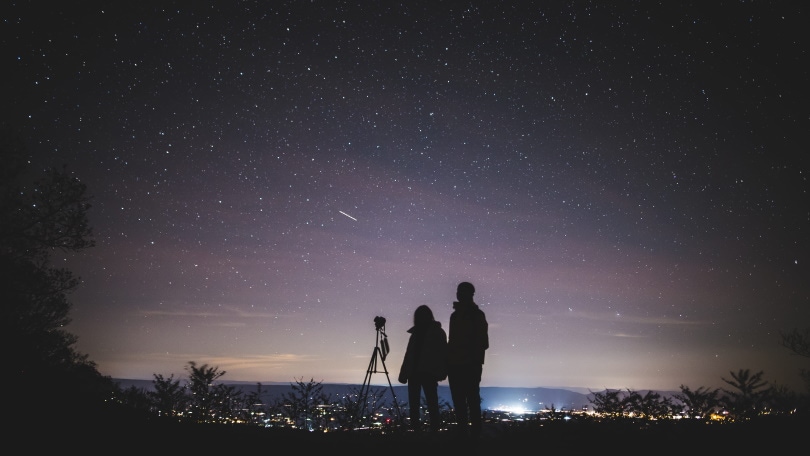
Minor Components
Minor components are important but not critical. If a pair of astronomy binoculars don’t have one or two of these components, they could still be great.
Weather Resistance
We rarely stargaze in the rain or snow, but it is usually dark. Accidents happen, and water resistance can be helpful if they should fall in a puddle or on the wet or snowy ground.
Durability
Just as with water resistance, we don’t expect to abuse our delicate astronomy binoculars, but accidents happen. We recommend that you never purchase binoculars that look or feel cheap and flimsy. Some astronomy binoculars might offer a rubber coating for improved grip and durability, which is a nice feature.
Eye relief
Eye relief refers to how close your eyes need to be to the lens to see a good image. Eye relief is a more significant issue with higher magnification devices like telescopes and spotting scopes because the picture delivered to the eye is much smaller. Still, it is essential to consider with binoculars, especially if you wear glasses. We recommend looking for an eye relief of at least 12-mm, but the higher the number is, the more comfortable they are to use.
Multicoated Optics
Multicoated optics refers to coatings applied that help them reduce glare, provide a clearer image, and reduce fogging. Multicoated lenses appear on higher-quality binoculars, so keep that in mind as you shop.
Tripod Adapter
Many people might consider binoculars to be handheld devices, but the ones designed for stargazing are quite large. Using a tripod with these types of binoculars is almost a requirement because of their high magnification and large light-gathering objective lenses. We highly recommend checking that your binoculars can attach to a tripod before purchasing them. We also recommend purchasing a tripod no shorter than 60-inches tall because you will use it to look directly overhead.
Digiscoping Cell Phone Adapter
Some models of astronomy binoculars allow you to connect them to your cell phone. This handy feature allows you to snap pictures and movies of your findings so you can enjoy them later. Attaching a cell phone to your binoculars also gives you a viewscreen so multiple people can look at once.

Conclusion:
We hope that you have enjoyed reading over our reviews of the best astronomy binoculars and are closer to deciding which you like best. If you’re still not sure, we recommend our choice for the best overall. The Gosky 4332111342 Titan Astronomy Binoculars features large objective lenses and plenty of magnification to get a better view of the stars. If you see something you like, you can connect your phone to snap pictures or make a movie. The Celestron 71198 Cometron Binoculars is our choice for the best astronomy binoculars for the money. These are strong enough to get you started identifying areas on the moon and picking out constellations for less than it would cost for two pizzas.
If you have enjoyed our reviews, please share these stargazing tools with your friends on Facebook and Twitter.
Featured Image: Free-Photos from Pixabay
Table of Contents
- A Quick Comparison of our Favorite Picks in 2025:
- The 7 Best Astronomy Binoculars for Stargazing:
- 1. Gosky Titan Astronomy Binoculars – Best Overall
- 2. Celestron 71198 Cometron Binoculars – Best Value
- 3. Zhumell Tachyon Astronomy Binoculars – Premium Choice
- 4. Orion 10151 Waterproof Astronomy Binoculars
- 5. Celestron 71009 SkyMaster Giant Binoculars
- 6. Levenhuk Bruno Plus Astronomy Binocular
- 7. ESSLNB Giant Binoculars
- Buyer’s Guide – Picking the Best Astronomy Binoculars
- Conclusion:
About the Author Robert Sparks
Robert’s obsession with all things optical started early in life, when his optician father would bring home prototypes for Robert to play with. Nowadays, Robert is dedicated to helping others find the right optics for their needs. His hobbies include astronomy, astrophysics, and model building. Originally from Newark, NJ, he resides in Santa Fe, New Mexico, where the nighttime skies are filled with glittering stars.
Related Articles:
When Were Binoculars Invented? History, Today & Future
How to Collimate Binoculars: 9 Expert Tips
Binocular Magnification Chart: Numbers & Distances Compared
What Is the Best Binocular Magnification for Hunting? Optical Features Explained
Can You Use Binoculars to Look At Stars? How to Choose the Right Pair
How to Choose Binoculars for Bird Watching: 10 Expert Tips
What Does 20X50 Mean on Binoculars? Our Helpful Guide
10 Best Binoculars in Canada of 2024: Reviews & Top Picks



